Toyota Avalon (XX50): Radio Receiver Assembly Communication Stop Mode. Rear Television Camera Communication Stop Mode. Restraints Occupant Classification System Module Communication Stop Mode
Radio Receiver Assembly Communication Stop Mode
DESCRIPTION
|
Detection Item | Symptom |
Trouble Area |
| Radio Receiver Assembly Communication Stop Mode |
Any of the following conditions are met:
- Communication stop for "Display and Navigation (AVN)" is indicated on the "Communication Bus Check" screen of the Techstream.
Click here 
- Communication stop history for "Display and Navigation (AVN)" is
indicated on the "Communication Bus Check (Detail)" screen of the
Techstream. (The Lost Communication Time value for "Display and
Navigation (AVN)" is 6 or more.)
Click here 
- Communication system DTCs (DTCs that start with U) that correspond to
"Radio Receiver Assembly Communication Stop Mode" in "DTC Combination
Table" are output.
Click here 
|
- Radio and display receiver assembly branch line or connector
- Power source circuit of radio and display receiver assembly
- Radio and display receiver assembly ground circuit
- Radio and display receiver assembly
|
WIRING DIAGRAM
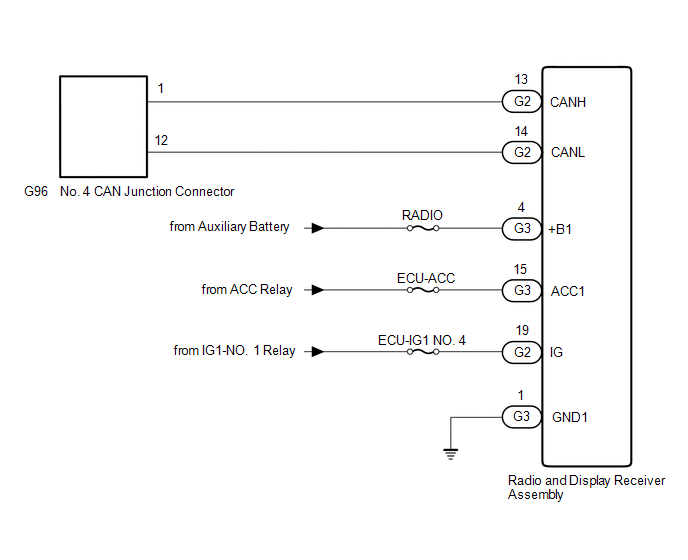
CAUTION / NOTICE / HINT
CAUTION:
When performing the confirmation driving pattern, obey all speed limits and traffic laws.
NOTICE:
HINT:
- Before disconnecting related connectors for inspection, push in on each
connector body to check that the connector is not loose or disconnected.
- When a connector is disconnected, check that the terminals and connector body are not cracked, deformed or corroded.
PROCEDURE
|
1. | CHECK FOR OPEN IN CAN BUS LINES (RADIO AND DISPLAY RECEIVER ASSEMBLY BRANCH LINE) |
(a) Disconnect the cable from the negative (-) auxiliary battery terminal.
(b) Disconnect the G2 radio and display receiver assembly connector.
| (c) Measure the resistance according to the value(s) in the table below.
Standard Resistance: |
Tester Connection | Condition |
Specified Condition | |
G2-13 (CANH) - G2-14 (CANL) |
Cable disconnected from negative (-) auxiliary battery terminal |
54 to 69 Ω | |
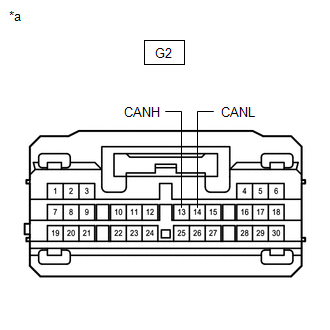 |
|
*a | Front view of wire harness connector
(to Radio and Display Receiver Assembly) | | |
| NG |
 | REPAIR OR REPLACE CAN BRANCH LINES OR CONNECTOR (RADIO AND DISPLAY RECEIVER ASSEMBLY) |
|
OK |
 | |
| 2. |
CHECK HARNESS AND CONNECTOR (POWER SOURCE CIRCUIT) |
(a) Disconnect the G3 radio and display receiver assembly connector.
(b) Measure the resistance according to the value(s) in the table below.

|
*a | Front view of wire harness connector
(to Radio and Display Receiver Assembly) |
- | - |
Standard Resistance:
|
Tester Connection | Condition |
Specified Condition |
|
G3-1 (GND1) - Body ground |
Cable disconnected from negative (-) auxiliary battery terminal |
Below 1 Ω |
(c) Reconnect the cable to the negative (-) auxiliary battery terminal.
(d) Measure the voltage according to the value(s) in the table below.
Standard Voltage:
|
Tester Connection | Condition |
Specified Condition |
|
G2-19 (IG) - Body ground |
Power switch on (IG) |
11 to 14 V |
|
G3-4 (+B1) - Body ground |
Power switch off | 11 to 14 V |
|
G3-15 (ACC1) - Body ground |
Power switch on (ACC) |
11 to 14 V |
| OK |
 | REPLACE RADIO AND DISPLAY RECEIVER ASSEMBLY |
| NG |
 | REPAIR OR REPLACE HARNESS OR CONNECTOR (POWER SOURCE CIRCUIT) |
Rear Television Camera Communication Stop Mode
DESCRIPTION
|
Detection Item | Symptom |
Trouble Area |
| Rear Television Camera Communication Stop Mode |
Any of the following conditions are met:
- Communication stop for "Parking Assist Monitor System / Rear Camera" is
indicated on the "Communication Bus Check" screen of the Techstream.
Click here 
- Communication stop history for "Parking Assist Monitor System / Rear
Camera" is indicated on the "Communication Bus Check (Detail)" screen of
the Techstream. (The Lost Communication Time value for "Parking Assist
Monitor System / Rear Camera" is 6 or more.)
Click here 
- Communication system DTCs (DTCs that start with U) that correspond to
"Rear Television Camera Communication Stop Mode" in "DTC Combination
Table" are output.
Click here 
|
- Television camera assembly branch line or connector
- Power source circuit of television camera assembly
- Television camera assembly ground circuit
- television camera assembly
|
WIRING DIAGRAM
w/ Panoramic View Monitor System:
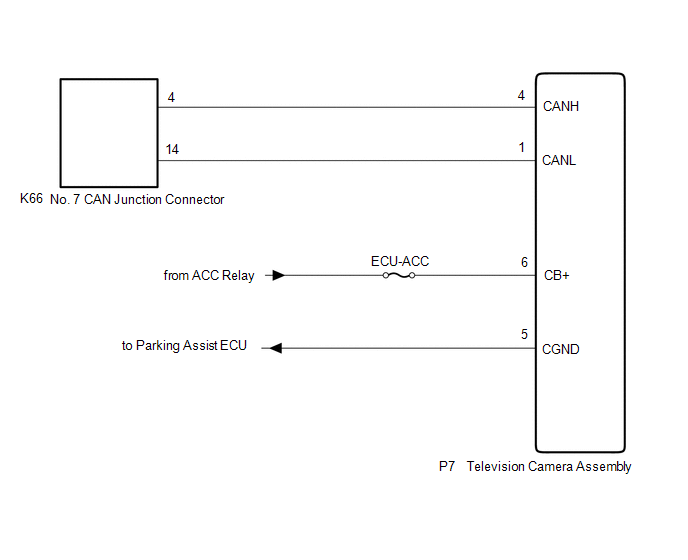 w/o Panoramic View Monitor System:
w/o Panoramic View Monitor System:
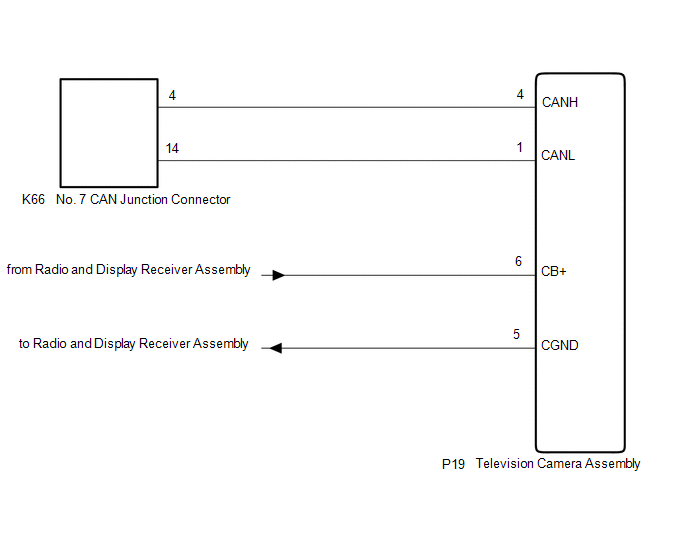
CAUTION / NOTICE / HINT
CAUTION:
When performing the confirmation driving pattern, obey all speed limits and traffic laws.
NOTICE:
HINT:
- Before disconnecting related connectors for inspection, push in on each
connector body to check that the connector is not loose or disconnected.
- When a connector is disconnected, check that the terminals and connector body are not cracked, deformed or corroded.
PROCEDURE
(a) Check vehicle type.
|
Result | Proceed to |
|
w/ Panoramic View Monitor System |
A |
| w/o Panoramic View Monitor System |
B |
| B |
 | GO TO STEP 4 |
|
A |
 | |
| 2. |
CHECK FOR OPEN IN CAN BUS LINES (TELEVISION CAMERA ASSEMBLY BRANCH LINE) |
(a) Disconnect the cable from the negative (-) auxiliary battery terminal.
(b) Disconnect the P7 television camera assembly connector.
| (c) Measure the resistance according to the value(s) in the table below.
Standard Resistance: |
Tester Connection | Condition |
Specified Condition | |
P7-4 (CANH) - P7-1 (CANL) |
Cable disconnected from negative (-) auxiliary battery terminal |
54 to 69 Ω | |
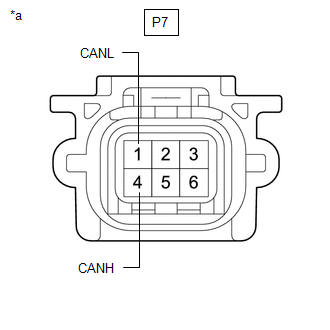 |
|
*a | Front view of wire harness connector
(to Television Camera Assembly) | | |
| NG |
 | REPAIR OR REPLACE CAN BRANCH LINES OR CONNECTOR (TELEVISION CAMERA ASSEMBLY) |
|
OK |
 | |
| 3. |
CHECK HARNESS AND CONNECTOR (POWER SOURCE CIRCUIT) |
| (a) Measure the resistance according to the value(s) in the table below.
Standard Resistance: |
Tester Connection | Condition |
Specified Condition | |
P7-5 (CGND) - Body ground |
Cable disconnected from negative (-) auxiliary battery terminal |
Below 1 Ω | |
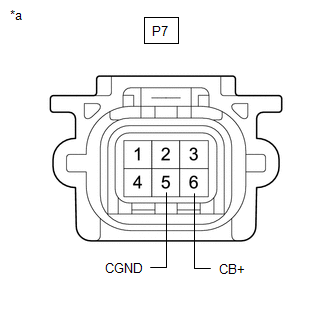 |
|
*a | Front view of wire harness connector
(to Television Camera Assembly) | | |
(b) Reconnect the cable to the negative (-) auxiliary battery terminal.
(c) Measure the voltage according to the value(s) in the table below.
Standard Voltage:
|
Tester Connection | Condition |
Specified Condition |
|
P7-6 (CB+) - Body ground |
Power switch on (ACC) |
11 to 14 V |
| OK |
 | REPLACE TELEVISION CAMERA ASSEMBLY |
| NG |
 | REPAIR OR REPLACE HARNESS OR CONNECTOR (POWER SOURCE CIRCUIT) |
| 4. |
CHECK FOR OPEN IN CAN BUS LINES (TELEVISION CAMERA ASSEMBLY BRANCH LINE) |
(a) Disconnect the cable from the negative (-) auxiliary battery terminal.
(b) Disconnect the P19 television camera assembly connector.
| (c) Measure the resistance according to the value(s) in the table below.
Standard Resistance: |
Tester Connection | Condition |
Specified Condition | |
P19-4 (CANH) - P19-1 (CANL) |
Cable disconnected from negative (-) auxiliary battery terminal |
54 to 69 Ω | |
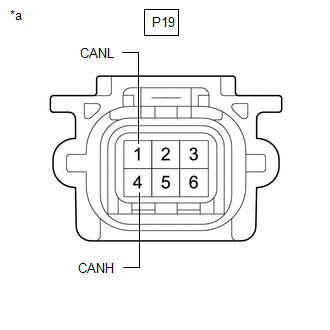 |
|
*a | Front view of wire harness connector
(to Television Camera Assembly) | | |
| NG |
 | REPAIR OR REPLACE CAN BRANCH LINES OR CONNECTOR (TELEVISION CAMERA ASSEMBLY) |
|
OK |
 | |
| 5. |
CHECK HARNESS AND CONNECTOR (POWER SOURCE CIRCUIT) |
| (a) Measure the resistance according to the value(s) in the table below.
Standard Resistance: |
Tester Connection | Condition |
Specified Condition | |
P19-5 (CGND) - Body ground |
Cable disconnected from negative (-) auxiliary battery terminal |
Below 1 Ω | |
 |
|
*a | Front view of wire harness connector
(to Television Camera Assembly) | | |
(b) Reconnect the cable to the negative (-) auxiliary battery terminal.
(c) Measure the voltage according to the value(s) in the table below.
Standard Voltage:
|
Tester Connection | Condition |
Specified Condition |
|
P19-6 (CB+) - Body ground |
Power switch on (ACC) |
5.5 to 7.05 V |
| OK |
 | REPLACE TELEVISION CAMERA ASSEMBLY |
| NG |
 | REPAIR OR REPLACE HARNESS OR CONNECTOR (POWER SOURCE CIRCUIT) |
Restraints Occupant Classification System Module Communication Stop Mode
DESCRIPTION
|
Detection Item | Symptom |
Trouble Area |
| Restraints Occupant Classification System Module Communication Stop Mode |
Any of the following conditions are met:
- Communication stop for "Occupant Detection" is indicated on the "Communication Bus Check" screen of the Techstream.
Click here 
- Communication stop history for "Occupant Detection" is indicated on the
"Communication Bus Check (Detail)" screen of the Techstream. (The Lost
Communication Time value for "Occupant Detection" is 6 or more.)
Click here 
- Communication system DTCs (DTCs that start with U) that correspond to
"Restraints Occupant Classification System Module Communication Stop
Mode" in "DTC Combination Table" are output.
Click here 
|
- Occupant detection ECU branch line or connector
- Power source circuit of occupant detection ECU
- Occupant detection ECU ground circuit
- Occupant detection ECU
|
WIRING DIAGRAM
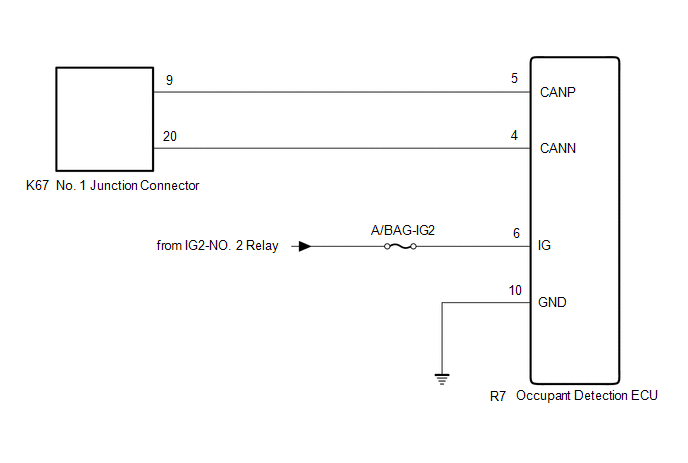
CAUTION / NOTICE / HINT
CAUTION:
When performing the confirmation driving pattern, obey all speed limits and traffic laws.
NOTICE:
HINT:
- Before disconnecting related connectors for inspection, push in on each
connector body to check that the connector is not loose or disconnected.
- When a connector is disconnected, check that the terminals and connector body are not cracked, deformed or corroded.
PROCEDURE
|
1. | CHECK FOR OPEN IN CAN BUS LINES (OCCUPANT DETECTION ECU BRANCH LINE) |
(a) Disconnect the cable from the negative (-) auxiliary battery terminal.
(b) Disconnect the R7 occupant detection ECU connector.
| (c) Measure the resistance according to the value(s) in the table below.
Standard Resistance: |
Tester Connection | Condition |
Specified Condition | |
R7-5 (CANP) - R7-4 (CANN) |
Cable disconnected from negative (-) auxiliary battery terminal |
54 to 69 Ω | |
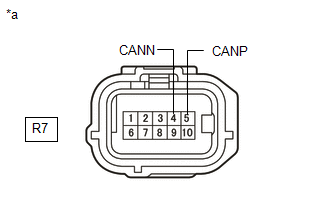 |
|
*a | Front view of wire harness connector
(to Occupant Detection ECU) | | |
| NG |
 | REPAIR OR REPLACE CAN BRANCH LINES OR CONNECTOR (OCCUPANT DETECTION ECU) |
|
OK |
 | |
| 2. |
CHECK HARNESS AND CONNECTOR (POWER SOURCE CIRCUIT) |
| (a) Measure the resistance according to the value(s) in the table below.
Standard Resistance: |
Tester Connection | Condition |
Specified Condition | |
R7-10 (GND) - Body ground |
Cable disconnected from negative (-) auxiliary battery terminal |
Below 1 Ω | |
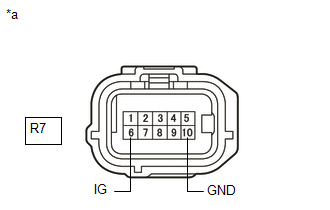 |
|
*a | Front view of wire harness connector
(to Occupant Detection ECU) | | |
(b) Reconnect the cable to the negative (-) auxiliary battery terminal.
(c) Measure the voltage according to the value(s) in the table below.
Standard Voltage:
|
Tester Connection | Condition |
Specified Condition |
|
R7-6 (IG) - Body ground |
Power switch on (IG) |
11 to 14 V |
| OK |
 | REPLACE OCCUPANT DETECTION ECU |
| NG |
 | REPAIR OR REPLACE HARNESS OR CONNECTOR (POWER SOURCE CIRCUIT) |
















 w/o Panoramic View Monitor System:
w/o Panoramic View Monitor System:






























